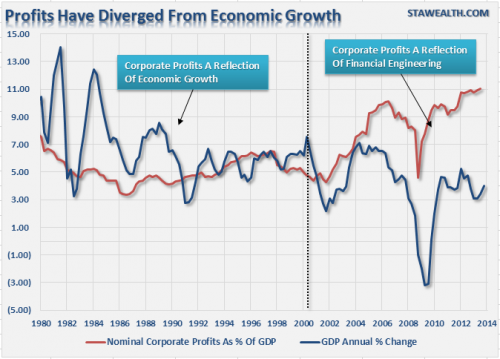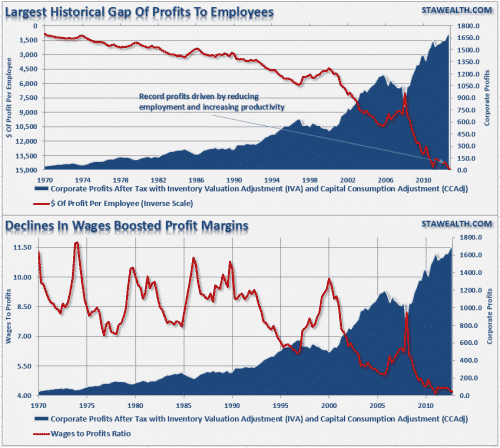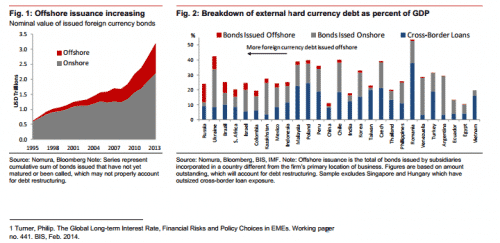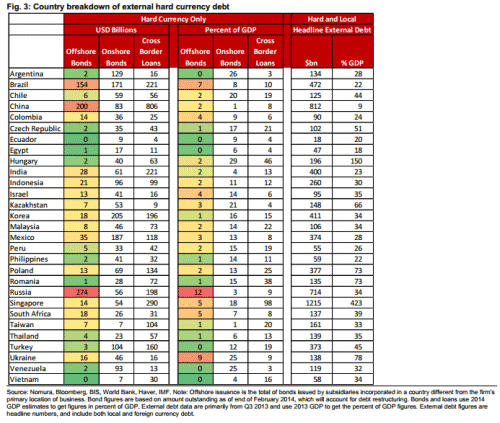Economic and market themes: 2014-03-07
Themes for today:
- The US faces political constraints in a cyclical downturn that will limit government response
- The US private surplus is under assault
- Europe is improving and upgrades to bank stocks are bullish
- The Fed tends to tighten before wage growth becomes sustained
- EM hidden external debt in eastern Europe makes Ukraine a potential point of contagion
- EM hidden external debt is large in China, Brazil and Russia
So, this is the day where I get to mash a bunch of thoughts into one post and tell you what I am seeing in the data and news flow that is relevant to your portfolio or macro view. One thing I think will be good to take a look at in light of this is the links because I am now going to include a lot more foreign-language links. I see a lot more of what’s happening due to the variety of foreign-language sources I read and I want to put the important stories in the links now.I will try to give a brief synopsis of what’s important in the story. But I recommend you use Google Translate to read the whole story if you find the synopsis interesting.
Let’s go to North America.
As I write this, the jobs numbers haven’t come out yet. But my macro view won’t be changed significantly by the numbers. {Update: Non-farm payrolls were +175,00 with 34,000 in prior revisions}. So I refer you to my post from Wednesday and the one from yesterday. This sees the US slowing and Europe gaining. Last night, Jim Rickards talked to us over at Boom Bust and was saying his macro view is similar. We haven’t aired that part of his conversation with us yet. But when we do, I will link to it.
On the US front, Rickards said something I agree with but that Warren Mosler pushed back on this morning on Twitter. Rickards said that the Fed took its balance sheet from $800 billion to $4 trillion in 6 years in order to provide liquidity after the crisis. In essence, he was concentrating on the Fed’s liquidity role to help disintermediated markets rather than the Fed’s QE programs to lift the US economy. And he said that the Fed will not have the political freedom to repeat the same magnitude of balance sheet expansion in another crisis i.e. operations that would take its balance sheet to $12 trillion. I agree with this assessment. Warren tweeted that what Rickards was saying would be true on the gold standard but isn’t true now. But I think he misreads what Rickards was implying, namely that the Fed is a political animal that exists solely because of Congressional authority. The constraint is entirely political and has nothing to do with the gold standard. The question is whether the Fed will have the political freedom to further dramatically expand its balance sheet in another liquidity crisis. Rickards says no and I agree.
Thinking about political limitations is important when thinking about likely outcomes in the next cyclical downturn. Will the US government politically have the green light to deficit spend at levels 7-10% of GDP? Will the Fed be permitted to expand its balance sheet? Will the Fed be permitted to buy municipal bonds? These are all political questions because the government and the Fed could do all of these things. But I believe the government won’t do any of these things until things get really bad because of political constraints. So a new downturn will be difficult unless more political policy space is available. This has nothing to do with ability and everything to do with willingness.
Right now, the US is showing how much the political constraints are dictating policy. Take a look at the chart in this tweet (newsletter and RSS readers click link).
Looks like a lot of pressure on pvt surplus RT @cullenroche: Update on Godley’s 3 sector financial balance. pic.twitter.com/XOVGC1Vrq3
— Edward Harrison (@edwardnh) March 6, 2014
What this chart is telling us is that the private surplus net of investment is decreasing at exactly the same rate that the government and trade deficits are decreasing. What one should take away from the chart is not that the sectoral balances are an ex-post tautology. Rather that any exogenously determined decision to move one of these balances will have an ex-post effect on the others. Put simply, targeting government deficit reduction inherently means targeting a reduction in the external deficit and/or a reduction in the private surplus.
The US is actively looking to make the government balance an exogenous policy variable by cutting spending and/or raising taxes because of targeting a lower deficit level. This has to lead to a lower private surplus. And so the question goes to where that private surplus net of investment erodes. The dynamics that Lance Roberts presents in terms of wages versus profits suggests that we are going to see mean reversion in earnings growth.
Now wages are not rising nearly robustly enough to support high growth in the US. But the most recent US government report shows slow productivity growth. Given the decline in the unemployment rate, the decline in productivity numbers says that firms can’t keep output up and cut headcount anymore. Either companies in the US, cut production or the have to add staff. That COULD be bullish for the economy. But given the high levels of inventories, the risk here is that inventories get purged as a means of increasing productivity. And that spells slower growth in the months ahead – even if it doesn’t mean mean reversion for margins quite yet.
The data then are not telling us that margins are about to mean revert.
Nonetheless, I see the tepid growth outlook as a contrast to the improving growth outlook in Europe and the lower earnings multiple there that reflects an extrapolation forward of present conditions. Just look at the upgrades we are seeing. The latest are the Belgian region of Flanders and a spate of 20-odd German and Austrian banks. That follows the upgrade of Santander and BBVA in Spain. The bank upgrades tell me that there is room to run up on bank shares and that we could see the credit crunch in Europe reverse, especially in the periphery where asset quality has improved because of the receding economic distress.
Also see Tim Duy’s piece on how the Fed tightens before wage growth has a chance to become sustained. It is very enlightening in terms of why we have low wage growth, an asset-based economy, and increasing income inequality. My takeaway is that the economic dogma believes wage growth leads to inflation. Central banks tighten before wage growth has a chance to flourish, thus exacerbating the trends that lead to the asset-based model. I see this as a clear sign that the last thirty years of over-reliance on monetary policy have been a destructive and direct contributor to so-called secular stagnation.
Skipping over to the emerging markets, Izabella Kaminska’s piece on hidden off-balance sheet debt was interesting, especially as we saw this as a factor in the Asian crisis in 1997. Two charts here from a Nomura group that includes Jens Nordvig.
This first chart shows an increasing amount of offshore debt issuance in emerging markets and gives an estimated breakdown of visible debt on-balance sheet in proportion to offshore debt and cross-border hard currency debt obligations. Some countries look worse than others.
This second chart gives you a sense of the magnitude of the hidden debt in absolute terms and relative to country GDP. The biggest economies have the biggest absolute numbers: Brazil, China and Russia.
Excluding Singapore, the numbers to watch on a debt to GDP basis are all in eastern Europe: Hungary, Ukraine, Poland, Romania. That is a potential point of contagion from the Ukraine crisis that bears remembering.
But my concern is Brazil where I believe the economy is slowing and corporate balance sheets look good. It would be shocking if this huge slug of offshore debt and cross border loans came out to show that in fact Brazilian corporates are not in good shape. As I have been saying for a few weeks now, corporates have shined during the EM crisis. We will see serious contagion and a real crisis only when they take it on the chin due to deteriorating domestic conditions and magnified exposure to foreign currency obligations from any drop in EM currencies. We are not there yet. But these charts tell you the vulnerability is there




Comments are closed.